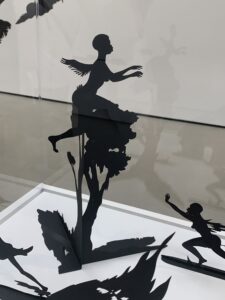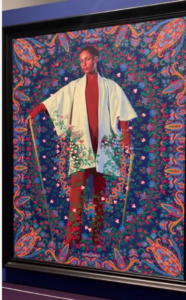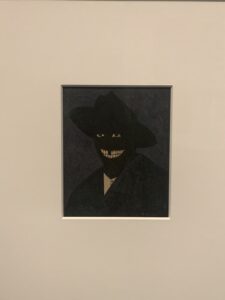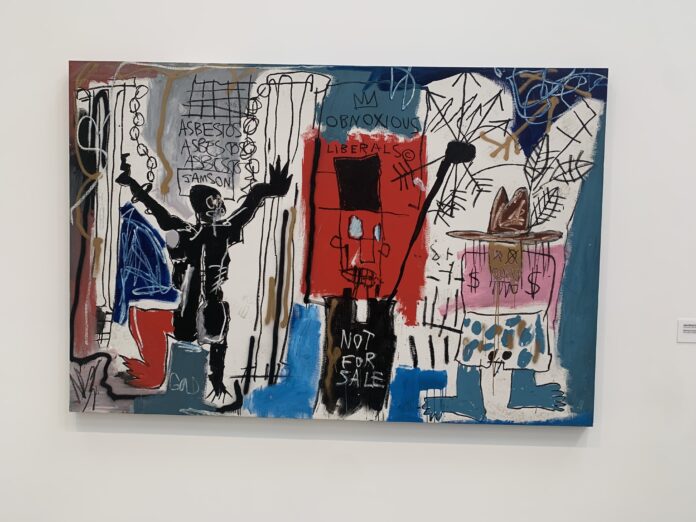By TheGrio
It is no secret that Black visual artists and painters in history have often been leaders of artistic innovation, and the 15 named below are but a few examples from a much longer list. These artists’ work tells compelling narratives, offers reflections on the Black experience, challenges societal norms, creates conversations around difficult topics like race and identity, advocates for justice and inspires countless viewers.
Expand your knowledge of Black American history by learning about these 15 Black visual artists, their career highlights, and their most famous works. Their work spans multiple mediums, from photography and painting to sculpting and assemblage making, and each of them used their respective pieces to create dialogues and inspire change.
Jean-Michel Basquiat
Neo-Expressionist artist Jean-Michel Basquiat (1960-1988) began his career on the streets in the late 1970s, quickly attracting attention for the graffiti art he and Al Diaz made under the tag SAMO. In 1981, Basquiat’s first major exhibition in the P.S. 1 Contemporary Art Center’s “New Work/New Wave” show transitioned him from street artist to gallery artist and, eventually, to central NYC art scene figure and famous Black artist.
Basquiat’s life and career were short — he tragically passed from a heroin overdose at 27 — but his legacy lives on. His paintings, which often dealt with themes of Black identity and social injustice, still resonate.

Kara Walker
Cut-paper silhouettes depicting scenes of racial and gender-based violence make Kara Walker (born 1969) a controversial visual artist. But disapproval from others doesn’t make her back down. She continues creating art that forces viewers to confront the uncomfortable truths of American history and explore the nature of race representation.
In addition to cut-paper silhouettes, Walker works in different mediums. In 2014, she went viral for her first-ever large-scale public art piece, “A Subtlety, or the Marvelous Sugar Baby.”
Faith Ringgold
Teacher-activist and multimedia artist Faith Ringgold (1930-2024) made her mark on American art through paintings, mixed media sculptures and “story quilts,” the latter of which she’s best known for. Ringgold’s story quilts combine quilting with paintings and text to tell stories and address race, gender and social justice issues.
“Tar Beach,” a story quilt made in 1988, is probably her most celebrated work. In 1991, it was adapted into a children’s book that earned the Harlem-born artist over 20 awards, including the Caldecott Honor.

Kehinde Wiley
Los Angeles-born painter Kehinde Wiley (born 1977) is best known for painting former President Barack Obama’s official U.S. Presidential portrait in 2018 and his large-scale portraits depicting people of color in the traditional settings and poses of Old Master paintings.
Like his work with other mediums, his paintings use visual language to address race, identity and power issues. Because of his distinct style and subject matter, he’s a leading figure in contemporary art.

Kerry James Marshall
Kerry James Marshall’s (born 1955) upbringing near the Black Panther Party headquarters gave him a feeling of social responsibility that influenced his work, which addresses Black history and represents Black life and culture. His painting,”Past Times,” a scene of a Black family engaging in high-class leisure activities, sold for $21.1 million. This is the world record for the highest price paid for a work by a living Black artist.
Jacob Lawrence
Jacob Lawrence (1917-2000) was not only the first Black artist to be represented by a major New York gallery, but he was also the first to have his work — the “Migration Series,” a collection of 60 paintings depicting the Great Migration of the early 20th century — acquired by the Museum of Modern Art.
Lawrence is one of the most important artists of his time, and with his work housed in collections around the globe, his legacy endures.
Betye Saar
Betye Saar (born 1926) is an assemblage art trailblazer and creator of a broad body of work exploring American social, political and economic issues, plus spirituality, mysticism and African traditions. The most famous of these is “The Liberation of Aunt Jemima.” The assemblage, created in 1972, was one of her first political pieces and transformed the stereotypical Aunt Jemima image into a symbol of Black empowerment and resistance.
Alma Thomas
Alma Thomas (1891-1978) did not produce her most famous works until retiring from a 35-year teaching career in the mid-1960s. But her late start didn’t deter her from success. She was the first Black woman to have a solo exhibition at the Whitney Museum of American Art and to be featured in the White House Collection (her piece, “Resurrection,” was unveiled there in 2015).
Abstract art pioneer Thomas drew inspiration from Henri Matisse, Johannes Itten and her local peers to develop her signature style.
Gordon Parks
Despite having no professional training, Gordon Parks (1912-2006) built a reputation as one of the most celebrated photographers of the 1940s-1970s. As the first Black photographer of “Life Magazine,” Parks created some of his most iconic work, including powerful photo essays documenting social injustices, poverty and the Civil Rights Movement.
His accolades span multiple disciplines, including writing and music composition. He even worked in cinema, directing “The Learning Tree” and “Shaft.”
Elizabeth Catlett
Elizabeth Catlett (1915-2012) is a famous Black female artist with a knack for combining abstract and figurative styles, plus African and Mexican art traditions, to create sculptures and prints depicting the Black experience, homing in on Black women. The University of Iowa’s first Master of Fine Arts in sculpture student, Catlett’s notable works include her thesis pieces, “Mother and Child” and “The Black Woman Speaks.” Like the rest of her art, these works show her commitment to celebrating Black culture and identity, something she’s remembered for today.
Henry Ossawa Tanner
The son of an African Methodist Episcopal bishop, Henry Ossawa Tanner (1859-1937), let his upbringing influence his work by creating religious-themed paintings. These would make him the first Black artist to achieve international acclaim.
Before painting biblical scenes, Tanner’s work focused on portraying Black people in a gentle light, deviating from the common Black stereotypes of the time. One of his most well-known paintings is “The Banjo Lesson,” an image of an older Black man teaching a boy to play the banjo and one of Tanner’s most famous paintings.
Lorna Simpson
Lorna Simpson (born 1960) solidified her position as a conceptual photography pioneer before finishing her MFA program. Her pieces, which often combine images and text, draw attention to and challenge views of social issues like race and gender. Additionally, they’ve earned her many awards and recognitions, including the International Center of Photography Infinity Award for Art in 2010, the J. Paul Getty Medal in 2019 and the honor of being the first Black woman to have a Museum of Modern Art solo exhibition.
Edmonia Lewis
Edmonia “Wildfire” Lewis (1844-1907) shattered glass ceilings in a white male-dominated industry when she became the first African-American professional sculptor in the U.S. and the first to achieve international accolades. Many of her works did not survive into the 21st century. However, those that did — “The Death of Cleopatra” and “Forever Free,” for example — are part of major museum collections.
Horace Pippin
An entirely self-taught artist and the grandchild of slaves, Horace Pippin (1888-1946) started his art career by experimenting with pyrography before moving to oil painting, the medium that would later bring him significant recognition and exhibitions at the Museum of Modern Art and the Pennsylvania Academy of Fine Arts.
Pippin’s folk paintings covered multiple topics, from portraits to biblical scenes. One of his most famous works is “The End of War: Starting Home,” a piece showing soldiers returning home from battle and reflecting on his personal wartime experience.
Aaron Douglas
You can’t speak of the Harlem Renaissance without acknowledging Aaron Douglas (1899-1979), a painter and graphic designer who played a leading role in the artistic and literary movement. Often called the “Father of Black American Art, Douglas had a unique style that blended Egyptian motifs, Art Deco elements and geometric shapes.
More of Douglas’s career highlights include illustrating multiple publications — his images in James Weldon Johnson’s “God’s Trombone” and Paul Morand’s “Black Magic” are among his most famous — and founding Fisk University’s art department.



































